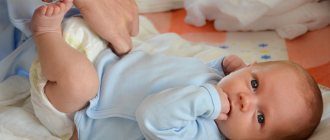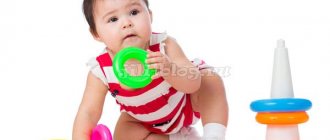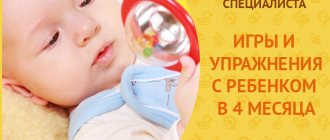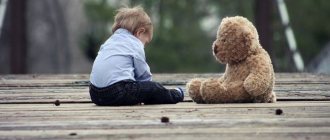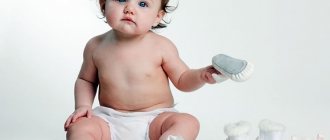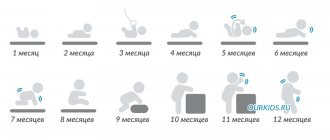Child development
Child at 3–4 months
A child at 3-4 months already begins to show attention to the world around him. Although some children do this almost from birth. But these are few; most spend the first weeks sleeping and eating.
By 2–3 months, if you touch the baby’s eyelashes, he will close his eyes and begin to rub his eyes with his fist or the back of his hand. He reacts in a similar way to touching other parts of the body: face, ears. From 4 months, with the same actions, it freezes. The same can be done with the tummy, legs, etc. in medical terms this is called the “cutaneous concentration reaction.” The little man begins not only to respond to touches, but also to think about his feelings.
At 3-4 months, the baby reacts to any discomfort or pain by crying loudly. But at the same time, increased sensitivity to tactile contact is a deviation from the norm. This may be an indicator of neuropathy or intracranial pressure.
Another advancement in development is the olfactory response to odors; it becomes constant and distinct. He already clearly distinguishes between pleasant and unpleasant aromas. If in the first case he listens, then in the second he sneezes or coughs. Same with flavor recipes. And since at this age the baby’s main food is breast milk, he reacts to its changes.
By 3 months, the baby visually recognizes some objects. Especially those that bring him pleasure - breasts, bottles, pacifiers. He begins to look at something intently. If these are some separately hanging/standing objects (watches, paintings, chairs), then they will most likely attract his attention. He can look at something for 7–10 minutes.
While awake, the child already monitors movement and studies the area where he is currently located. And towards the end of 4 months, he begins not only to look, but also tries to pick up the object of interest. But these are just attempts; precise grasping skills will come closer to six months.
A sense of color is formed
The sensation of color is actively formed. At 3–4 months, the child clearly distinguishes contrasts and also knows 2 to 3 colors. There is an opinion that first the baby recognizes and distinguishes yellow, then blue, red and green. This is of great importance when raising him. He needs to be offered toys and things to look at those colors that he can recognize.
It also finds the source of sound well. If you sing or simply raise your voice, he will turn his head towards the source, while he can be either in the arms of an adult or in a crib. At this age, he responds positively to sounds.
The so-called revitalization complex is clearly expressed. When you pay attention to him or when he sees/hears a loved one (mom, dad), he begins to smile, laugh, twitch his arms and legs, thus showing his joy.
By this age, unconditioned reflexes almost completely disappear. By the end of 3 months, the baby is trying to straighten his body. This is due to the maturation of certain brain centers. In the future, thanks to this, the child’s posture and voluntary movements will be determined.
Baby learns to roll over from stomach to back
By 3 months, he can already hold his head in an adult’s arms in a vertical position, or lift it and hold it while lying on his stomach for a short time. Another skill is standing on your arms with your elbows bent. If you rest your hand on your baby's legs, bent at the knees, he will push off and make a kind of jerk forward. A little later he will learn to feed himself with his feet and thus crawl on his bellies.
Read: Developing while playing games
At 3–4 months, the baby already learns to roll over from his stomach to his back. After a month, he can do the opposite movement - from his back to his stomach.
These development indicators are only approximate, since each child is individual. You should also remember about the baby’s temperament, which has been present since birth, the time of birth and the pregnancy period. All these factors have a significant impact on the formation of his skills.
Physical development
In the third month, your baby grows and develops no less intensively and rapidly than in the previous two. The rapid development of all organs and systems of the child does not slow down. During the third month of life, the toddler will gain approximately 800 grams of mass, and its height will increase by approximately three centimeters.
The development of the baby’s respiratory system can be judged by the following indicators. The minute breathing volume of a three-month-old baby is twice as large as that of a newborn.
The digestive system does not lag behind in its anatomical and functional progress. The surface area of the gastric mucosa tripled by the third month.
The central nervous system is amazing at the speed of cellular and tissue development at this stage, which is directly reflected in the characteristics of mental development, which we will talk about a little later. The way the cells of various analytical and regulatory centers of a child’s brain develop, which are now rapidly generating connections among themselves, is largely influenced by the nature of the baby’s diet.
It should be noted the enormous importance of breastfeeding for the successful development of the nerve centers of a small person. A number of ingredients in breast milk (the amino acid taurine or long-chain omega fatty acids) are extremely important for the rapidly developing brain of the infant.
Baby care
Every morning the baby needs to have a daily toilet after he wakes up. It is the same throughout the first year and is not particularly different.
First of all, you need to pay attention to the skin. By their transformation, you can understand changes in the baby’s health.
Even with careful care, diaper rash sometimes occurs. If they persist for quite a long time and do not go away despite all efforts, then you should consult a doctor, as this may be a symptom of allergic dermatosis. In this case, certain treatment is necessary, and it should also be remembered that in this case the skin tends to become wet and ulcerate when overheated. Ventilate the room as often as possible and leave the baby to take air baths.
There should be daily washing. If possible, then not only after defecation, but also when changing a diaper or after each urination. Girls are washed with special care. They do this so that the water flows from front to back.
A common occurrence in children is the appearance of seborrhea - crusts on the head. They must be removed with extreme caution, as they can damage the skin, thereby causing inflammation and suppuration. First you need to lubricate them with oil, steam them under a scarf or cap, and then carefully comb them with a fine-toothed comb and wash them off with soapy water.
Nails need to be trimmed as they grow, as dirt can accumulate under them and the baby can scratch himself and get an infection.
But parents decide for themselves whether to cut their hair or not. Shaving is not recommended, as it can damage the hair follicles.
Most babies love to swim. You shouldn't deny them this pleasure. If it is very hot, then the number of water procedures can be increased to 1-2 times a day. If the baby is afraid of water, use wet wipes until he stops feeling afraid. Wash with soap no more than 2 times a week, as it dries out the skin.
Height and weight of children aged 3 months WHO data
| 3 months | Bottom line | Upper limit |
| Boys' weight, kg | 5,0 | 8,0 |
| Girls' weight, kg | 4,5 | 7,5 |
| Boys' height, cm | 57,3 | 65,5 |
| Girls' height, cm | 55,6 | 64,0 |
| Boys' head circumference, cm | 38,1 | 42,9 |
| Head circumference of girls, cm | 37,1 | 42,0 |
Hardening the child
Tempering a child should begin at a very early age. In this case, he will get used to such procedures and his immunity will be stronger.
Daily toilet for babies
First of all, you need to take air baths every day. It is good to do this in the sun, thus preventing rickets. Before starting, thoroughly ventilate the room where the child will be. They should start at 22–23°C, gradually reducing by 1–2°C, bringing it to 18–19°C. The duration of the initial procedure is short - only 1-3 minutes. Then the child can do this for 20–25 minutes. During the air baths, you can play with the baby, give him a massage or gymnastics. Be sure to monitor his standing, do not allow hypothermia. It can be expressed in hiccups, restlessness, or, conversely, a decrease in motor activity.
Read: How to develop a child at 4 years old physically and intellectually
It is not necessary to carry out such procedures strictly according to the regime. An air bath is taken between diaper changes and after bathing, or simply by undressing the baby and leaving him to lie there for a while.
Hardening begins at 1–2 months. First, this is wiping with a damp terry cloth soaked in warm water. Next, the water temperature is gradually reduced. First, wipe the arms and legs and immediately wipe them dry. After getting used to it, do the same with the breast and back.
Mental development of children at 3 years old
By the age of 3, children usually have many new skills and abilities in the field of mental abilities. A three-year-old child should be able to:
- Compare and sort objects by size, length, shape, color;
- Find the same object;
- Compose puzzles from 4 parts;
- Name primary colors and shades;
- Know poems and songs;
- Make up a story based on a familiar picture with the help of an adult;
- Know the names of some trees, dishes, furniture, animals, clothes, transport, vegetables and fruits;
- Know basic geometric shapes;
- Tell him what he did during the day.
Exercises for babies 3–4 months old
The set of exercises includes both physical exercises and certain moments of massage actions. They are carried out at a time when the child is happy, there are no irritating factors, he is full and does not want to sleep. At least 50–60 minutes should pass after the last meal.
Gymnastics classes include exercises that develop motor skills and sensations, visual and auditory reactions. To make the process more calm and interesting, various devices and toys are used.
You need to comment on your every action. The baby understands everything, he hears the intonation, feels the softness and warmth of your hands, gentle movements. Do everything smoothly and with love.
- They start with their hands. Place the baby on his back. Stroke his right hand, holding it in your right hand. The left one makes circular and spiral movements, rubbing upward, towards the elbow. Then change hands. Repeat steps 5-6 times.
- Place your thumbs in the child's hands. Then spread your arms wide to the sides and cross them on your chest, repeating the exercise 7-8 times.
- Let's move on to the legs. Hold the baby's right foot in your right hand. Knead with your left hand, starting from the foot, moving up to the thigh. Kneading, stroking, circular movements. Switch legs, holding it with your left hand. Repeat 5-6 times.
- Take the baby's legs in your hands, alternately bend and unbend them, pressing them to the tummy. Repeat 7-8 times.
- Abdominal massage. Use your palms to move from the lower back to the pubis so that your hands seem to converge. Repeat 7-8 times.
- Breast massage. Use your fingers to move in the intercostal space without pressing on the chest. Repeat 2-3 times.
Next they move on to exercises.
- Roll over from back to stomach. Take the baby's leg with your right hand, and put it in the baby's finger with your left so that he grabs it. Then slowly and gently pull the leg, turning the pelvis and also pull your finger, encouraging the baby to roll over. Do the same in the other direction, first returning the child to the starting position. Repeat 1-2 times.
- Turn the baby over onto his tummy. Take it by the ankles of both legs, and with the other hand fix the upper torso. Gently lift the legs and bend them towards the head in the lumbar region, but without being too zealous. Repeat 5-6 times.
- Crawling (reflex). The child's legs are slightly bent. Place your palm on your feet so that he rests on them and pushes off. Repeat 5-6 times.
- Place the baby in your arms, tummy down. Then pull them forward. The child will reflexively stretch his arms and legs to the sides, bend his back and raise his head. Do this exercise 2-3 times.
- Lay the baby on his back. Take him by the body with both hands on both sides and gently lift him, giving him a semi-sitting position, then return him to his original position. When lowering, be sure to hold the head to prevent shock or startle. Do this exercise 2-4 times.
It must be remembered that if the baby is capricious and does not want to exercise, then the exercises should be interrupted. Don't insist, let him rest and try again during the next waking period.
Height and weight of a child at 3 months according to domestic pediatricians
| 3 months | Bottom line | Upper limit |
| Boys' weight, kg | 4,9 | 7,0 |
| Girls' weight, kg | 4,8 | 6,3 |
| Boys' height, cm | 56,5 | 62,0 |
| Girls' height, cm | 56,2 | 61,8 |
| Boys' head circumference, cm | 39,0 | 42,5 |
| Head circumference of girls, cm | 38,0 | 41,2 |
| Boys chest circumference, cm | 36,5 | 41,6 |
| Girls chest circumference, cm | 37,3 | 41,4 |
Games at 3–4 months
Even at such an early age, you can start playing with your baby. This will teach him how to communicate and bring you even closer.
- Abracadabra. When your baby becomes most talkative, you also talk to him. Repeat the sounds after him and offer new ones.
- Airplane. The child is placed on your forearm and “flyed” around the room with him.
- Dancing. At this age, children love smooth, calm music. So turn on this one, take him in your arms and dance. A waltz would work well in this case.
- Let's go. Lay him on his back and use his legs to play some nursery rhyme. In this case, something like: “Big feet were walking along the road...” is appropriate.
- Exchanges of glances. Catch the baby's gaze. Then slowly bend your head to one side, then to the other. You will see, he will repeat the movements after you.
- Hide and seek. Throw a scarf over your face and say: “Where is mommy?” and taking it off say: “Here she is!”
- Take it away! Show your child the toy and get his attention. When he reaches for it, let him grab it tightly. Hold it in your hands and rock it until he grabs it.
Read: What does raising a 2-year-old child consist of?
It is best to use bright, contrastingly colored toys. You can use household items: spoons, towels, etc.
Mental development
How to understand why a baby is crying? What actions should parents take to help the baby calm down? This will help to understand the nature and characteristics of the crying itself. You just need to listen to him carefully.
- Hunger cries are usually louder than all others. It often starts with small sobs and quickly gains momentum, becoming shrill. Such crying means that the baby is ripe for feeding.
- Drowsy crying is usually accompanied by rubbing the hands of the eyes and twisting the head. Parents should help their little one fall asleep by rocking them to sleep and keeping them quiet.
- Painful crying begins suddenly, often on a very high note. Children at this age most often experience stomach or ear pain.
- Crying with increased intracranial pressure, as a rule, begins in the evening at the same time, on the same note.
The easiest way to calm a screaming toddler is to give him a pacifier.
. Sometimes you can unwrap the baby and let him suck his own finger. This alternative method has its advantages - the finger will never fall to the floor, it does not need to be boiled, and the baby’s hand can be found even in pitch darkness.
Swimming lessons
How to teach swimming without a circle?
At this age, the water temperature should not be higher than 35–36°C. In order for the baby to swim independently, various devices are used. The most modern is a swimming ring, which is attached to the neck. Help your child. Place your hand under your feet so that he pushes off (remember the “Crawling” exercise). Make raking movements with your hands.
You can teach swimming without a circle. In this case, several support techniques are used. “Bucket” support is when the mother holds her hand under the armpits, the child’s chin rests on her forearm. The arms are moved forward, the fingers are spread out.
Grasping with both hands under the armpits, so that the thumbs are on the shoulder blades, and the rest on the chest is called “girth from behind.”
If the mother is in the same bath, then she will be comfortable with “face to face” support: this is like an inverted form of “girth from behind”, the thumbs are on the chest, the rest are on the shoulder blades.
Classes begin with sliding and wiring. By placing the child with his back on his forearm, he is taught to float on the water, first holding him with his hands and gradually leaving him without support for a few seconds. Gradually increase time without parental hands. The “bicycle” exercise is connected to this skill so that he can push with his hands.
With the right approach to working with your child, you can achieve great results in the future. This is not only his physical development, but also a psychological component, since communication with the parent, especially with the mother, is simply necessary for the baby at this age.
Early development techniques in the following video:
09 Mar 2021 Valeria 378
Share this post
We recommend reading along with this article
- How to choose the right toys for babies
- What a 4 month old baby can do - description...
- Features of the development of a newborn child by week, stages...
- Feeding, sleeping, staying awake in the mode of a 2 month old baby
- The correct development of a one-month-old baby, what should be able to...
- What does the growth chart for a child up to one year tell you?
- How to make a children's room with a unique and inimitable design
- The age when babies begin to crawl, parental help, norms...
- How to develop a child at 4 years old physically and intellectually
Discussion: 3 comments
- Karina:
08/08/2019 at 03:15It is very important to talk with the child during this period, this contributes to the development of the baby’s speech, he will begin to talk faster. But for some reason some mothers ignore this process.
Answer
- Alevtina:
09/11/2019 at 09:14
I didn’t know what to play with a baby of such a young age, so I hung toys in the crib. I was involved in my daughter’s development at an older age, when the child had more understanding.
Answer
- Irina:
02/09/2020 at 15:46
At that age, our favorite toys were soft educational toys with rustling elements. The baby looked at them with pleasure, touched them and studied them as best he could. And for mom there was five minutes of freedom at this time)
Answer
When you urgently need help
Each child develops in his own way and at his own speed, however, the following stages need to be paid attention to. If the baby has difficulty with them, this may indicate an illness or developmental problems.
Consultation with a doctor is necessary if you notice that your baby at 3 months:
- didn't start smiling;
- does not hold his head up on his own for at least 30 seconds when he is picked up vertically;
- cannot hold his head up for more than 1 minute while lying on his stomach;
- by two months and later does not pay attention or interest in his hands;
- does not calm down even for a short time, despite the fact that you try your best to console him;
- is silent, does not try to make any sounds or babble;
- still clenches her fists reflexively;
- most of the time the eyes are crossed, as at birth;
- does not pay attention to new faces or, conversely, is too frightened at the sight of new people or a change of scenery;
- does not grab or hold objects, toys, etc.;
- does not follow moving objects with his eyes;
- does not react in any way to sharp or frightening sounds.
Baby mode
Let's figure out how much sleep a 4-month-old baby should have, what kind of routine and sleep he needs.
Sleep for a little one is an important moment in his life and development. Therefore, you can and should correctly approach the problem of what your daily routine should be. The baby needs good nutrition, good sleep, and daily walks. Only in this case will the baby’s weight and height be normal.
A 4-month-old baby sleeps at least two or three times: in the morning after breakfast, after lunch or an evening walk.
At night, the regime is also important, because if it is followed, the baby sleeps better. Sleep is not interrupted and becomes longer. The child at 3 months slept worse, this was due to gases that were bothering him, so he did not leave your arms.
How can you tell if your baby needs sleep? If games and other educational activities do not help keep your baby occupied and do not distract him from crying, and you notice that he is yawning or rubbing his eyes, then it’s time to go to bed.
It is better to release the baby from your arms and rock him in the cradle so that addiction does not occur. Weaning children off their hands is not an easy task. Undoubtedly, at this age it is important to give more love and attention, which does not mean constantly carrying the baby in your arms.
The temperature in the bedroom should not be high, the norm is no more than 22-25 degrees. After all, such an indicator can also slow down the growth and development of a child at 4 months.
The baby sleeps well even if you have done therapeutic exercises, which will help stretch the muscles and disperse the blood, in which case the sleep will be stronger and longer. The touch of a mother's hands and quiet games will prepare the child for sleep.
You can ventilate the room, filling it with fresh air. This daily procedure will help your baby feel good and allow him to breathe freely, especially if there are problems with the upper respiratory tract. The norm for such ventilation is at least 3-55 times a day, of course, in the absence of the baby in the room at the moment.
Diet is also important, because it also lays the foundation for healthy and strong development. Complementary feeding for a child at 4 months should be given in small quantities, mainly vegetable puree or a small amount of juice.
If after feeding the baby spits up, do not worry, this is completely normal (in isolated cases). But if the baby burps frequently (the norm is no more than a couple of times a day), parents should find out the cause of this trouble, because this can cause problems with the esophagus.
The child burps up particles of curdled milk, and at this moment, excess air comes out, which the baby could have sucked in along with food. To find out why your baby spits up frequently, contact your pediatrician. Of course, most often a baby at this age burps up air along with food particles, which is normal.
If your baby doesn’t eat well or stops eating altogether, immediately go to the doctor for a consultation. Of course, before you make a fuss, make sure that he is feeling well: active, cheerful and not capricious; in such cases, you need to wait a little and do not force him to eat.
The entire daily routine, both nutrition and sleep, are important parts of development, and they simply must be followed daily. Remember: complementary feeding is not an important detail at such an early age; children should not be forced if they have no desire to eat vegetable puree.
If your baby is not gaining weight well or, conversely, is overweight, you should immediately consult a doctor, as you may miss the onset of a disease or other health problem. Remember: at 4 months the baby should weigh at least 6 kg.
Care and hygiene
The most important thing for a mother, in the heat of care and troubles about the baby, is not to forget about mandatory vaccination against diseases in the first year of the child’s life. An online vaccination calendar, which is necessary to determine the priority and date of vaccinations, can help you with this.
Mandatory hygiene procedures for a child at 4 months are as follows:
- Washing.
- Cleaning ears and nose.
- Cleaning after every bowel movement.
- Gymnastics.
- Massage.
- Air baths.
- Daily bathing.
Remember that the boy’s genitals should be washed only with clean water without using soap, because... soap can cause irritation or even burns.
Do not stretch the foreskin under any circumstances - this can injure the child!
The girl also needs to be washed without soap and only with clean hands under warm running water from bottom to top, so as not to spread the infection inside the genitals.
A new stage in the baby’s life – he is 3 months old!
Finally, the sleepless period of night colic has passed. The child is now calmer, as a result of which the mother gets more opportunity to sleep. Now the baby begins to show greater interest in the events of his life and the world around him.
Start getting used to the baby’s new state - “I’m exploring the world.” Try to give your baby the opportunity to gain new experiences. However, do not forget to be careful - the load on the baby and his nervous system can be great, resulting in fatigue and fatigue. If the baby begins to be capricious, take him in your arms, lightly press him to you, rock him and calm him down. Look into the baby's eyes, smile - eye contact is as important as tactile contact.
